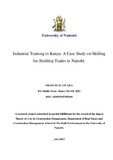| dc.description.abstract | Building industry plays a vital role in the economic growth and development of Kenya, both through its products and the employment created in the construction processes. The TVET Act (ROK, 2013) is a major policy initiative that was envisaged as an occupational field to provide the foundation for productive and satisfying careers and at the same time offer specialized preparation for employment. It is a crucial aspect of Human Resource Development (HRD) being implemented in national institutions and financed by the Government and the private sector. The Industrial Training Act (ROK, 1983) and The Industrial Training (Amendment) Act (ROK, 2011a) among other legal provisions, mandate the National Industrial Training Board (NITB) to ensure that personnel engaged in industry is well trained for good performance; ensure an adequate supply of trained work force for the industry; and share the cost of training as evenly as possible among employers. The training is financed from a Levy Fund that employers contribute to in accordance with the number of workers in employment in every particular month of the year. Despite the existence of this provision, most contractors do not contribute to the Fund yet contributors are expected to be reimbursed part or all of the costs incurred in respect of their training as well as that of their staff.
This study investigated the dynamics of industrial training in the building industry in Nairobi. The main areas of study were specifically how operatives finance acquisition, and upgrading of their knowledge and skills in the building industry; how they are coping with changing technology in the building industry; the level of utilization/awareness of the Industrial Training Levy Fund among the contractors. Descriptive design was adopted to depict the state of affairs. Systematic sampling was applied in respect of contractors and convenience sampling in respect of the operatives.
The findings indicate that most operatives train informally under qualified operatives or in accredited government institutions with negligible skill upgrading. Most of them finance their training are assisted by their parents and /or guardians with minimal input from their employers. Further it was found out that most of the artisans cope with the evolving technology through observation of fellow workers or reading manuals from manufacturers. Lastly, the study established that most of the contractors were not keen to register with DIT/NITA since they viewed the contribution of the Levy as a tax with only about 22% utilizing the Levy Fund to train their operatives. This is due to the fact that
vi
most contractors do not understand the processes of seeking authority to train and training cost reimbursement from the Directorate of Industrial Training/National Industrial Training Authority.
The study recommends that to enhance widespread skills training National Industrial Training Authority (NITA) recruit and sponsor training for the operatives in accredited institutions irrespective of where they are employed. Further to enable the operatives cope with changing technology, NITA in liaison with the professional bodies should mount short term courses in the relevant trades. Finally, a robust awareness campaign should be instituted by NITA to counteract the perception that the Levy Fund is a form of a tax and also inform the contractors on the process of application for training of operatives and refund of the costs. | en |

